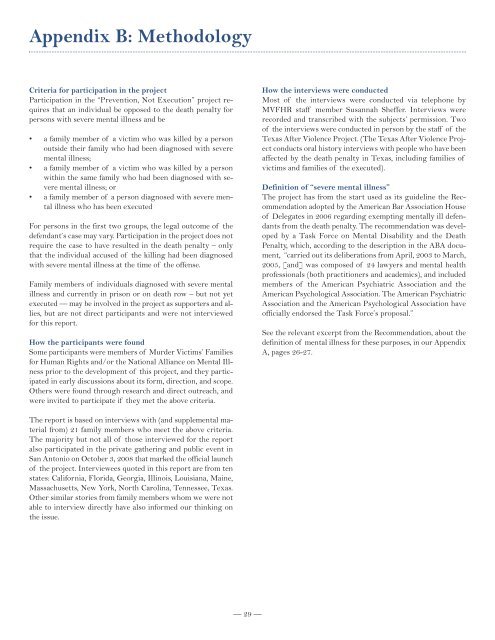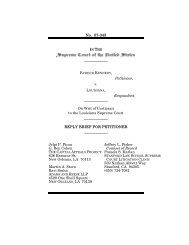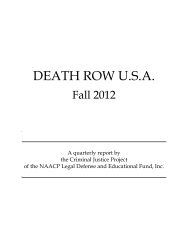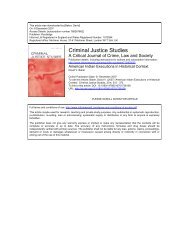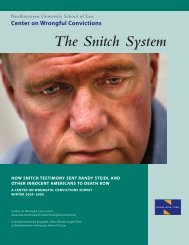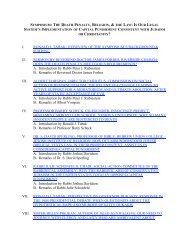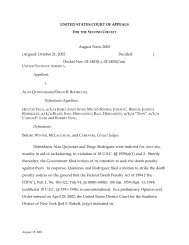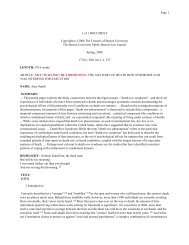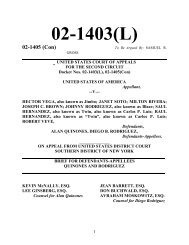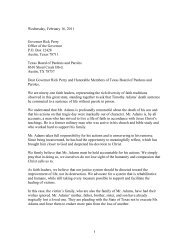Appendix B: MethodologyCriteria <strong>for</strong> participation in the projectParticipation in the “Prevention, Not Execution” project requiresthat an individual be opposed to the death penalty <strong>for</strong>persons with severe mental illness and be• a family member of a victim who was killed by a personoutside their family who had been diagnosed with severemental illness;• a family member of a victim who was killed by a personwithin the same family who had been diagnosed with severemental illness; or• a family member of a person diagnosed with severe mentalillness who has been executedFor persons in the first two groups, the legal outcome of thedefendant’s case may vary. Participation in the project does notrequire the case to have resulted in the death penalty – onlythat the individual accused of the killing had been diagnosedwith severe mental illness at the time of the offense.Family members of individuals diagnosed with severe mentalillness and currently in prison or on death row – but not yetexecuted — may be involved in the project as supporters and allies,but are not direct participants and were not interviewed<strong>for</strong> this report.How the participants were foundSome participants were members of Murder Victims’ <strong>Families</strong><strong>for</strong> <strong>Human</strong> <strong>Rights</strong> and/or the National Alliance on Mental Illnessprior to the development of this project, and they participatedin early discussions about its <strong>for</strong>m, direction, and scope.Others were found through research and direct outreach, andwere invited to participate if they met the above criteria.How the interviews were conductedMost of the interviews were conducted via telephone byMVFHR staff member Susannah Sheffer. Interviews wererecorded and transcribed with the subjects’ permission. Twoof the interviews were conducted in person by the staff of theTexas After Violence Project. (The Texas After Violence Projectconducts oral history interviews with people who have beenaffected by the death penalty in Texas, including families ofvictims and families of the executed).Definition of “severe mental illness”The project has from the start used as its guideline the Recommendationadopted by the American Bar Association Houseof Delegates in 2006 regarding exempting mentally ill defendantsfrom the death penalty. The recommendation was developedby a Task Force on Mental Disability and the DeathPenalty, which, according to the description in the ABA document,“carried out its deliberations from April, 2003 to March,2005, [and] was composed of 24 lawyers and mental healthprofessionals (both practitioners and academics), and includedmembers of the American Psychiatric Association and theAmerican Psychological Association. The American PsychiatricAssociation and the American Psychological Association haveofficially endorsed the Task Force’s proposal.”See the relevant excerpt from the Recommendation, about thedefinition of mental illness <strong>for</strong> these purposes, in our AppendixA, pages 26-27.The report is based on interviews with (and supplemental materialfrom) 21 family members who meet the above criteria.The majority but not all of those interviewed <strong>for</strong> the reportalso participated in the private gathering and public event inSan Antonio on October 3, 2008 that marked the official launchof the project. Interviewees quoted in this report are from tenstates: Cali<strong>for</strong>nia, Florida, Georgia, Illinois, Louisiana, Maine,Massachusetts, New York, North Carolina, Tennessee, Texas.Other similar stories from family members whom we were notable to interview directly have also in<strong>for</strong>med our thinking onthe issue.__ 29 __
Appendix C: Further Reading and ResourcesREPORTS AND ARTICLESReports mentioned in Appendix B:American Bar Association Recommendation and Report onthe Death Penalty and Persons with Mental Disabilitieshttp://www.ndrn.org/issues/cj/ABA%20Resolution-%20feature%20article305.pdfGrading the States 2009: A Report on America’s HealthCare System <strong>for</strong> Adults with Serious Mental Illnesshttp://www.nami.org/Content/NavigationMenu/Grading_the_States_2009/Full_Report1/Full_Report.htmResponding to People Who Have Been Victimized by Individualswith Mental Illnesseshttp://consensusproject.org/downloads/responding.pdfCreating More Victims: How Executions Hurt the <strong>Families</strong>Left Behind http://www.mvfhr.org (click on “Publications”)Other useful reading:Honberg, Ronald S. “The Death Penalty and Mental Illness:The Injustice of Imposing Death Sentences on People withSevere Mental Illness,” Catholic University Law Review, Summer2005 (54 Cath. U.L. Rev. 1153)Mental Illness and the Death Penalty Resource Guide, byKristin Houle. Includes talking points, case studies, ideas <strong>for</strong>action, and lists of further resources. http://www.tcadp.org/uploads/documents/mental%20illness/MIDP%20Resource%20Guide-second%20edition.pdfThe Execution of Mentally Ill Offenders. Amnesty International,2006. This comprehensive report illustrates howcurrent legal safeguards have failed to protect offenders withsevere mental illness from being sentenced to death andexecuted in this country. It includes numerous case studies, aswell as an appendix of 100 individuals with mental illness whohave been executed since 1977. http://web.amnesty.org/library/Index/ENGAMR510032006.“Recommendation and Report on the Death Penalty andPersons with Mental Disabilities.” Mental and PhysicalDisabilities Law Reporter. September/October 2006. Thisarticle provides background in<strong>for</strong>mation on and the rationalebehind the ABA recommendation to prohibit the deathpenalty <strong>for</strong> persons with mental disabilities and disorders.w w w. n d r n . o r g / i s s u e s / c j / A B A % 2 0 R e s o l u t i o n -%20feature%20article305.pdf.Talking Points: Mental Disabilities and the Death Penalty.Judith G. Storandt, J.D., National Disability <strong>Rights</strong> Network;Ronald Tabak, J.D., Co-chair, Death Penalty Committee, ABASection of Individual <strong>Rights</strong> & Responsibilities; Ron Honberg,J.D., National Alliance on Mental Illness; and David Kaczynski,Executive Director, New Yorkers Against the Death Penalty.March 2007. These comprehensive talking points address variousissues related to the intersection of the death penalty andmental illness. www.ndrn.org/issues/cj/Talking%20Points.pdf.ORGANIZATIONAL WEBSITESAmerican Bar Association www.abanet.orgAmnesty International USA www.aiusa.orgDeath Penalty In<strong>for</strong>mation Center www.deathpenaltyinfo.orgMental Health America www.mentalhealthamerica.netMurder Victims’ <strong>Families</strong> <strong>for</strong> <strong>Human</strong> <strong>Rights</strong> www.mvfhr.orgNational Alliance on Mental Illness www.nami.orgNational Coalition to Abolish the Death Penaltywww.ncadp.orgNational Disability <strong>Rights</strong> Network www.ndrn.orgOffice <strong>for</strong> Victims of Crime www.ojp.usdoj.gov/ovc/Texas After Violence Project www.texasafterviolence.orgTreatment Advocacy Centerwww.treatmentadvocacycenter.org/BLOGSFor Victims, Against the Death Penalty. Visit <strong>for</strong> updatesabout the work of Murder Victims’ <strong>Families</strong> <strong>for</strong> <strong>Human</strong> <strong>Rights</strong>and news and examples of victim opposition to the deathpenalty. http://www.mvfhr.blogspot.comPrevention Not Punishment. Visit <strong>for</strong> current news and developmentsrelated to mental illness and the death penalty inTexas and around the country. The blog includes links to local,state, and national organizations and other resources.http://preventionnotpunishment.blogspot.com/FILM“Executing the Insane: The Case of Scott Panetti.” This documentarywas produced by Texas Defender Service, in associationwith Off Center Media. It chronicles the case of ScottPanetti, who was sentenced to death in Texas despite a long,documented history of paranoid schizophrenia. It is a compellingillustration of the impact that Panetti’s mental illness –and his death sentence – has had on his family. 2007. 27 minutes.Available on DVD or online at www.texasdefender.org/panettidocumentary.asp.__ 30 __


